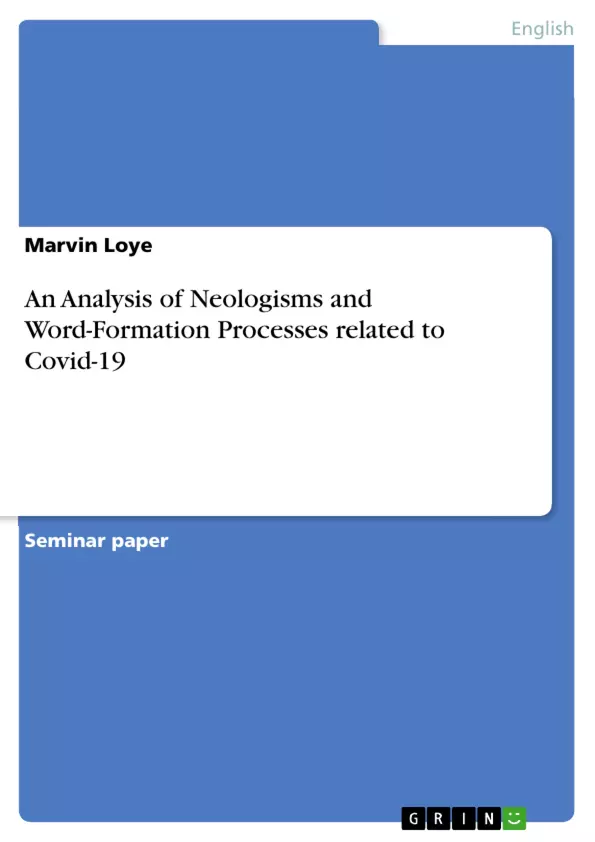This research focuses on the linguistic field of morphology, investigating neologisms that emerged due to the Covid-19 pandemic. Firstly, morphological terms and definitions are presented in order to explain how these words were created, followed by a thorough explanation of how neologisms are formed through word-formation processes. Then, this study inspects a corpus of hundred neologisms related to the coronavirus to examine through which types of word-formation they were produced. In addition, the research aims to figure out what processes are the most productive regarding these Covid-inspired words. Finally, the results are discussed and tabulated.
At the beginning of 2020, the infectious coronavirus disease, caused by the SARS-CoV-2 virus, spread globally and turned into a worldwide pandemic (Coronavirus Disease (COVID-19), n.d.). As a result, not only did the virus cause six million deaths and a socio-economic crisis, but it also influenced the English language (WHO Coronavirus (COVID-19) Dashboard, n.d.). The human language is always changing and evolving because it needs to adapt to the changing needs of its speakers (Birner, n.d.). Eventually, certain developments such as the outbreak of the coronavirus will automatically lead to a linguistic change in unpredictable ways (Crystal, 2003). Since individuals had to face social distancing, lockdowns, quarantines, and the dangers of the coronavirus itself, a vast number of neologisms, meaning new words in a certain language, emerged in order to describe the changing realities (Yule, 1996). Such a change in language can influence “formal linguistic aspects of phonology, morphology, syntax, and semantics”, as well as non-linguistic factors of pragmatic and social aspects of language (Al-Salman & Haider, 2021).
Inhaltsverzeichnis (Table of Contents)
- Introduction
- Morphological Terms and Definitions
- Word-Formation Processes
- Morphemic Word-Formation Processes
- Derivational Affixation
- Compounding
- Conversion
- Back-Formation
- Non-Morphemic Word-Formation Processes
- Clipping
- Blending
- Initialism
- Borrowing
- Coinage
- Morphemic Word-Formation Processes
- Data and Methods
- Results
- Conclusion
Zielsetzung und Themenschwerpunkte (Objectives and Key Themes)
This research investigates the formation of neologisms related to the COVID-19 pandemic, focusing on the linguistic field of morphology. The study aims to analyze how these new words were created and to identify the most productive word-formation processes used to describe the changing realities associated with the pandemic.
- Morphological terms and definitions related to word-formation processes
- Analysis of morphemic and non-morphemic word-formation processes in English
- Identification of the most productive word-formation processes for COVID-19 related neologisms
- Examination of a corpus of COVID-19 related neologisms to determine their word-formation processes
- Discussion of the results and implications for the study of language change.
Zusammenfassung der Kapitel (Chapter Summaries)
- Introduction: The chapter introduces the research topic of neologisms related to the COVID-19 pandemic and their significance in reflecting the evolving nature of language. It highlights the impact of the pandemic on various aspects of language and society, emphasizing the emergence of new words to describe the changing realities.
- Morphological Terms and Definitions: This chapter delves into the fundamental concepts of morphology, defining key terms like morpheme, free and bound morphemes, inflectional and derivational morphology. It clarifies the importance of analyzing word-formation processes by examining the smallest meaningful units of language.
- Word-Formation Processes: This chapter explores the various ways new words are formed, distinguishing between morphemic and non-morphemic processes. It elaborates on morphemic processes like derivational affixation, compounding, conversion, and back-formation, emphasizing the role of affixes and their impact on word meaning.
- Data and Methods: This chapter outlines the research methodology used in the study. It explains the data collection process, including the corpus of neologisms related to COVID-19, and the methods employed to analyze the data, such as identifying the word-formation processes used.
- Results: This chapter presents the findings of the study, analyzing the most productive word-formation processes identified in the corpus of COVID-19 related neologisms. It provides a detailed overview of the results and their implications for understanding language change.
Schlüsselwörter (Keywords)
This research explores the field of morphology and its role in the formation of neologisms related to the COVID-19 pandemic. Key terms and concepts include neologisms, word-formation processes, morphemic and non-morphemic processes, derivational affixation, compounding, conversion, back-formation, and the influence of the pandemic on language evolution.
- Citation du texte
- Marvin Loye (Auteur), 2022, An Analysis of Neologisms and Word-Formation Processes related to Covid-19, Munich, GRIN Verlag, https://www.grin.com/document/1243975



